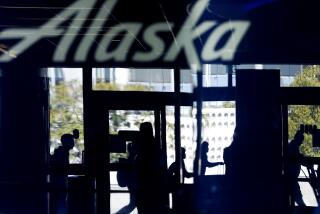Airplane boarding through one door, not two
Question: I was wondering why airlines load only through one (front) door? Thirty years ago on my first international trip, I flew out of JFK in New York and that was the first and last time I experienced two-door loading of an aircraft. We all know that the backup into the aircraft starts on the jet bridge almost as soon as the second set of rows is called to board the plane. Why not use two doors?
--Ed Mulcahy, Vancouver, Canada
Answer: Surprise. It’s mostly a money issue.
In the olden days, passengers could use two doors to get on and off. Stairs were built into the old 727s, and when the plane landed, the steps unfolded and people exited front and rear.
Airlines pretty quickly discovered that those stairs were taking up revenue-generating seats. And although some airports still use mobile stairs (think Burbank), not every airport is blessed with the kind of weather we have, which is to say that tramping down those mobile steps isn’t nearly as fun if you’re deplaning in Buffalo in a blizzard.
The debut of the jet bridge also marked a change in the way airlines operate.
The days of “buying a ticket and getting on a plane with no advance planning is long since passed, both because of security and also now because of the departure control requirements,” said Zane Gresham, director of worldwide airports and aviation practice group for Morrison & Foerster law firm. “The entire way of handling passengers has changed.”
Jet bridges are not only more comfortable, climatically speaking, but they also are safer than having passengers wandering around on the tarmac, especially if prop planes are in use. Given that it made life easier for passengers, we could almost call it the original Bridge to No Wear.
But as with almost all innovations, there’s a catch.
“The biggest issue is that [the bridge] takes up a lot of space,” said Nathan Smith, an analyst for aerospace and defense sectors for Frost & Sullivan, a global research and marketing firm. “When you load from the front and the rear, it takes up two slots.”
In the future, however, dual jet bridges may be the norm for jumbo jets, including the Airbus A380, which can (but usually doesn’t) seat up to 800 people. (Smith says 550 is more the norm, but it depends on how many luxuries, such as beds that lie flat or private little cabins, are built into the plane.)
It can be time-consuming to load a long-haul flight simply because the more time you have to kill, the more junk you take with you and the more you try to stuff into the overhead compartment. So, yes, there’s that backup onto the jet bridge.
You may see dual boarding at terminals that have been newly remodeled or constructed, Smith said.
But don’t expect it any time soon at terminals that don’t serve the jumbos. Translation: Boarding will continue to be cattle-call style. Head ‘em up, move ‘em out.
Yippee ki yay, pardner.
Have a travel question or dilemma? Write to travel@latimes.com.
More to Read
Sign up for The Wild
We’ll help you find the best places to hike, bike and run, as well as the perfect silent spots for meditation and yoga.
You may occasionally receive promotional content from the Los Angeles Times.







